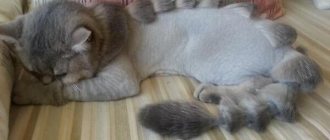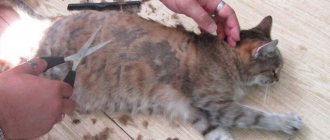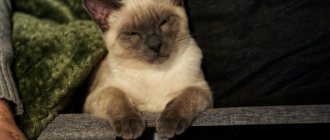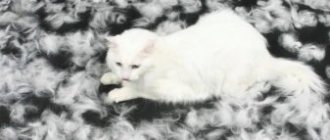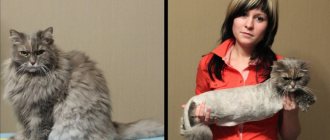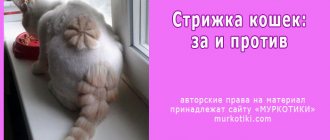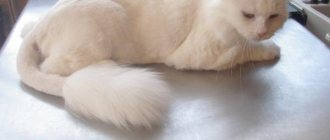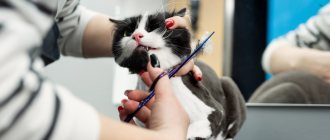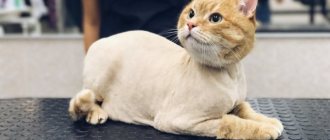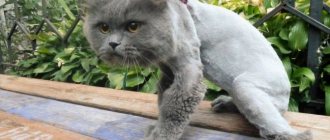How to cut a cat's hair at home: useful tips
Cats living in an apartment need full care. They need to be kept clean, fed properly, and their coats maintained in good condition. Moreover, many breeds require periodic shortening, and it is not always possible to carry out such a procedure at the veterinarian. In this case, you can use a special technique that teaches how to cut a cat’s hair at home.
Reasons and frequency of haircuts
Cats need to be trimmed from time to time for several reasons. Most often, this activity should be carried out with animals that have long hair, due to its constant rolling into clumps, which cause numerous inconveniences. Cat haircuts can have different purposes:
- For hygiene purposes. In this case, the process is necessary due to the wool becoming tangled and matted. The animal may get too dirty, and the type of contamination will be paint products or certain building materials that cannot be removed with shampoo.
- In certain situations, the fur of very old or sick cats that are unable to take care of their “fur coat” is shortened. This procedure prevents the formation of hair balls in the stomach, which often cause intestinal blockage. It is also necessary in conditions of elevated air temperatures, when there is a risk of overheating of the pet.
- Due to prolonged molting. In this case, cutting will make keeping the animal much easier.
- For medicinal purposes. For certain diseases of cats, haircutting may be recommended by a veterinarian. Indications for such a procedure are usually infectious skin diseases, dermatitis, the appearance of various parasites, as well as hyperplasia of the sebaceous glands. Trimmed wool makes it possible to treat the skin with medications more effectively, and this significantly shortens the treatment process.
- Decorative haircuts. Such hairdressing services for pets are nothing more than a whim of their owners. With the help of a model haircut, owners try to emphasize the individuality of their pet and the characteristics of its character.
- Exhibition haircuts are designed to demonstrate the standards of their breed in animals.
The frequency of procedures associated with shortening hair depends on the intensity of its regrowth. This usually takes from three to six months, depending on the breed of the pet, its health condition and age. On average, it is recommended to provide cats with such hairdressing services no more than two or three times a year.
Removal of tangles should be carried out as they appear.
Model haircuts can be performed more often, but in this case the health of the animal, the condition of its coat, and the season of the year should be taken into account. Therapeutic and hygienic haircuts are usually carried out as needed.
Contraindications and harm
Sedative medications have contraindications, which are important to familiarize yourself with before giving it to your cat . Most sedative medications should not be given to your pet in the following cases:
- low blood pressure;
- pregnancy;
- the onset of lactation;
- presence of diabetes mellitus or a history of urolithiasis;
- individual intolerance to the components of the medication.
You should not give sedatives to young animals whose age has not reached 12 months.
It is difficult to say unequivocally regarding the harm caused to the cat’s body. There are no absolutely safe medicines. It is impossible to predict exactly how the body of a particular cat will react to the components of the drug.
Note! Long-term use of sedative tablets can cause addiction, inhibition of reaction and apathy in a pet.
Main nuances
Cat owners should be aware that not all animals can have their fur trimmed. The restrictions may be influenced by the following factors:
- Color-point or typing type of color. In this case, the regrown hair on the belly and back will be darker in color than before the haircut.
- Unbearable character and increased activity, when the pet cannot be brought into a calm state. In such a situation, you can use anesthesia, but first you need to take into account all the possible risks. Narcotic drugs can cause cardiac arrest, put you into a coma, and contribute to the failure of the kidneys and liver. If there is no other solution, anesthesia can be replaced with sedatives or muscle relaxants. But such an idea must be approved by a veterinarian, and drugs must be administered strictly under his guidance.
- It is not recommended to cut short-haired cats unless absolutely necessary, since in the heat their vital functions are not disrupted and tangles never form. Grooming of such breeds is only relevant in extreme situations, for example, if the animal is soiled with oil paint.
When planning to cut your cat's hair, you should be aware that the structure of its fur, length and color may change, and the regrowth process usually takes several months. It is forbidden to cut the hair on the animal's head, on the pads of the paws and in the inside of the ears.
When should you cut your cat's hair?
Cat grooming is done first when:
- the animal develops tangles;
- His fur is too thick and he is hot.
After the procedure, the cat, freed from excess fur, will feel much better.
Then a haircut is simply necessary for the health of the animal. But in fact, there are several types of grooming that are used in different situations.
- Hygienic. This is done to keep the cat's fur in order. Groomers trim it evenly and also trim off excess hair between the toes and on the pads of the paws. Hairs are also removed from the ears, and hair around the anus and genitals is processed.
- Exhibition . Animals are cut in a special way, emphasizing their advantages and hiding their shortcomings.
- Home.
This grooming is carried out not only by professionals, but also by the cat owners themselves and is a regular hair trimming. After it, combing and bathing your pets becomes much easier.
See also: Singapore cat: care and maintenance
Recommendations from experts
The procedure for grooming domestic cats is a last resort; as a rule, it is resorted to due to the systematic formation of mats or the need for treatment based on medical indications. In most cases, animals with long hair undergo a similar process.
To prevent pets from getting tangled, it is recommended to comb them with special devices: a slicker brush and a furminator. In addition, animals need to be washed using high-quality products that help maintain the well-groomed condition of their “fur coat”. Such actions not only have a beneficial effect on the health of animals, but also relieve their owners from scraps of fur scattered throughout the house.
You should know that if someone in your household is allergic to a pet’s fur, cutting the pet’s fur will not help. This is explained by the fact that in this case the reaction of the immune system is caused directly by the skin secretions of the animal, as well as by its saliva preserved on the hair.
The coat of cats belonging to semi-longhaired breeds not only protects them from the cold, but also prevents overheating. This type is not inclined to form tangles and only needs regular bathing and combing. This applies to species such as Maine Coon, Norwegian and Siberian cats.
Persian breeds have thin and delicate fur, which after shearing is restored much easier than that of their counterparts. Persians have a very difficult time withstanding hot weather , so their coat is often shortened.
Features of grooming
It is impossible to carry out such a procedure on your own and get an effective result without the help of an assistant. Before cutting, in addition to the necessary equipment, it is recommended to purchase a collar for the animal, specially designed to protect against its bites. In addition, it is worth stocking up on compounds that have disinfecting properties, for example, chlorhexidine or hydrogen peroxide. They may be needed in case of possible cuts.
Required Tools
Since cat fur is thick and fine in structure, using scissors and clippers on people would be impractical. To provide hairdressing services to animals, you should prepare specialized tools directly for grooming. Such a set should include:
- a comb in the form of a metal comb with a flat shape and a slicker brush;
- thinning scissors or their straight version with rounded blunt ends;
- a machine designed for shaving animals (including in hard-to-reach places), as well as corresponding knives, since it is almost impossible to trim a cat with scissors alone at home;
- a high-power hair dryer with a heat-off function;
- nail clipper for cats;
- accessories for fixation in case of active resistance of the cat.
Is it possible to cut cats?
Giving cats haircuts is not only possible, but also necessary, in certain cases. In most cases this is not necessary. Frequent haircuts are harmful to the animal.
Cats' fur is brushed daily, even if it is short. It is advisable to bathe and trim nails once a month. Particular attention should be paid to caring for the ears and eyes. The eyes are washed with cotton wool soaked in a tea solution if tear discharge is present. Ears also need to be cleaned regularly.
But the most difficult procedure is grooming the cat. It requires a set of special tools: massage brushes, tangle cutters, combs, furminators, hair dryers, slickers, wool rakes, regular and thinning scissors. All these tools are available to professional groomers.
If you want to cut the animal yourself, ordinary scissors, brushes and a clipper will suffice. Also prepare a table on which to place the animal and the iodine. It will need to be used in case of cuts. It is best if a family member helps you groom your cat. He will hold the animal if it begins to resist.
How to cut a cat's hair beautifully at home?
If you decide to take an animal into your home, you will have to take care of it, keep it clean, and feed it nutritious food.
Most often, cats appear in families, which themselves are gentle and affectionate animals, and it is a pleasure to play with them. If the owners are new, they have many questions about caring for their pet, for example, the rather pressing topic of keeping the fur clean and which cat breeds need to be trimmed. And concern immediately arises regarding the question of how to trim a cat’s hair at home. After reading this article, you can make sure that the procedure does not present any difficulties.
Ridding an animal of excess hair is the key to a healthy pet.
Cats with long, fluffy hair most often need a haircut, because these animals shed much more than short-haired cats, and hairballs also constantly roll up, causing a lot of inconvenience. And in this case, the decision to trim the cat is a necessity; you just need to understand how to carry out this procedure yourself at home.
I would like to note that getting rid of excess hair from an animal is not only a guarantee of cleanliness and the absence of hairs throughout the house, but also a guarantee of a healthy pet. Cats constantly lick their fur, so the hairs penetrate into the stomach, and if this happens constantly, whole balls of hair begin to collect. In general, cats are able to regurgitate the collected fur, but this is not always possible, and as a result, obstruction of the gastrointestinal tract occurs. Therefore, a haircut is a necessary event.
Veterinary clinics provide animal grooming services
To trim a cat, you need to prepare yourself and prepare the animal. There are specialized veterinary clinics that provide hairdressing services for animals, and if it becomes a problem for you to do the haircut yourself, you can always turn to specialists, but the procedure will cost money.
What is used to groom cats?
Attention! At home, medium-sized scissors are used, but the most convenient option is a clipper.
A hair clipper is most convenient for the procedure
This device, unlike scissors, is easy to use and cannot cause injury to your pet if used correctly. The only drawback is the sound of the machine running, which can greatly frighten the cat, and this will create certain problems during the grooming process (the animal begins to struggle and scratch).
If you are even afraid to imagine how to trim a cat at home, then you better turn to a professional. Some veterinary clinics use anesthesia for overly exuberant cats, but this is very dangerous for older cats.
At home, it is difficult to trim a cat for participation in exhibitions, but it is absolutely possible to do this for hygienic purposes.
It is advisable for the clipper to operate quietly
For convenience and ease of cutting, the first step is to choose a high-quality model of the device, preferably not too loud and, of course, not the cheapest. The stores offer mechanical (manual) and electric machines. After studying all the pros and cons that the sales consultant can tell you about, you will be able to choose the most convenient option.
What could be the consequences of a haircut?
But it’s still better to use the services of professionals and resort to cutting your hair yourself extremely rarely. Moreover, it is advisable to use specialized tools for grooming cats.
Even after a professional haircut, cats experience unpleasant consequences.
- After grooming, the color and structure of the animal's coat changes.
- Long-haired cats' fur does not grow back to the length it used to be.
- Under no circumstances should you trim your eyebrows or whiskers; this will have a negative impact on your cat’s health.
- It is also not recommended to cut off all the hair on the tail. You should leave at least a “lion” tassel on the tip of the tail.
See also: Features of keeping a white cat: pros and cons
How does haircut affect animals?
Is it possible to cut a cat's hair without causing any changes, and how will cutting it at home affect the pet's behavior?
Haircut significantly affects hair growth
Almost all long-haired breeds change coat color, becoming darker or lighter. It happens that haircut significantly affects the growth of fur, sometimes this process accelerates, and in some cases, on the contrary, it becomes slower, and in rare cases it stops growth completely.
Cat grooming at home by professionals
If you are hesitant to start grooming yourself, you can call in professionals. What is attractive about grooming at home with the help of specialists?
- your pet does not experience the stress associated with being in an unfamiliar environment;
- a professional will cope with the task faster and better;
- there is no need to purchase the necessary tools:
- you get rid of unnecessary hassle and save time.
- It is possible to trim several animals quickly and at a reasonable price.
Professionals will give your pet a haircut quickly and at a high level; this is more convenient and practical than cutting the animal’s hair yourself. In addition, they can offer custom haircuts for your pet.
- Haircut "Dragon". This haircut is different in that a mohawk remains on the cat’s back, and the rest of the hair except the head is completely removed.
- Puma haircut. In this case, only the hair from the back surface of the body is removed. The head, paws and tail are not cut.
- Haircut "Lion". After shearing, the animal really looks like a lion, as it is left with only the “mane” and fur at the tip of its tail.
See also: How to properly wash a cat: practical recommendations
Haircut "Lion"
How to properly trim your pet's hair yourself?
To understand how to properly trim a cat at home, you need to prepare:
- a convenient place, it can be a table or an ironing board;
- a comfortable comb;
- small scissors;
- a special hair clipper;
- hydrogen peroxide and iodine (for treating wounds, if any appear).
Sequencing:
- Initially, you should shorten your cat's claws. For this, manicure scissors are usually used: firstly, this tool can be found in every home, and secondly, high-quality scissors will help you deal with claws without unnecessary problems; If you wish, you can purchase a special device at a pet store - a nail clipper, which is easy to use, and its cost is quite affordable.
- Before you start trimming the nails, you need to disinfect the tool, usually using alcohol. Next, you need to take your pet’s paw in your hand and lightly press on the pad, after which the cat will release its claws, at this moment, without removing your fingers from the pad, begin the procedure of cutting the claws; To complete the procedure, it is recommended to use a nail file to file off the sharp ends.
- For the first time, it is better to trim a cat at home, with the help of a person who will help you hold the animal correctly, and, as a rule, it is much easier to cope with the procedure together. So, the partner, having laid the cat on its side, must hold its limbs.
- If the animal begins to behave quite aggressively, it is better to use a plastic collar.
- Next, they trim the cat with a clipper, starting from the sides, the main thing is not to worry and try not to shake your hands, because an animal that behaved calmly, sensing the owner’s excitement, can show both anxiety and aggressiveness, and then you will no longer be able to do the procedure at home.
- After the sides, the back and belly are trimmed; Particular attention is paid to the abdominal area where the nipples are located.
- It is possible to cut the hair both in the direction of hair growth and against it.
- If the haircut is carried out with an electric clipper, you need to remember that the nozzle must be at least 3 mm.
- In order for everything to go without injury to the animal, you should trim the resulting lumps on the cat with scissors during the procedure, since using a clipper at home this will be impossible and quite unpleasant for the pet itself.
- During grooming, the animal's skin must be stretched to avoid cuts.
- When cutting hair at home, the head, paws at the ends and tail are usually left untouched; this haircut will look like a lion's.
- If necessary, you can use thinning scissors to go through the untrimmed wool.
- When the whole procedure has come to an end, the cat is washed with clean water, or bathed with shampoo and dried with a hairdryer.
It is possible to cut the hair both in the direction of hair growth and against it.
Cat grooming
In general, cat grooming is a subject of constant discussion among professional breeders and simply lovers of these beautiful creatures. Okay, you can somehow agree with grooming dogs, but mocking a cat - no, no way! This is the opinion held by the majority. And even if there is wool in the house, there are even felt boots, it hangs in shreds on the carpets, furniture and curtains, because of it the whole family suffers from allergies, and the cat himself languishes from the heat - but he looks like a king.
And yet it is wrong. Cats, especially long-haired ones, are not able to care for their fur themselves, despite round-the-clock efforts and natural cleanliness. Therefore, periodically cutting your cat’s hair is the best option to solve the problem.
Grooming serves as an excellent alternative to daily, sometimes painful, both for the animal itself and for its owner, combing. Constantly tangled hair, animal shedding, and cats sometimes swallow a lot of their fur, which clogs the intestines and causes obstruction...
Grooming cats is a very real way out of the situation. Grooming long-haired cats, very popular in the United States, is much less common in European countries. Although, according to experts who constantly cut their long-haired, mainly Persian, cats, a high-quality, professionally performed haircut has a positive effect on the structure of the animal’s coat.
In order for the trimming process to be successful, you need to remember the following.
Unless absolutely necessary, it is better not to cut the cat at all , especially if the cat is very restless in character. Some animals experience severe stress during this procedure and depression afterwards; it is difficult for them to get used to their new appearance.
If you are participating with your pet at an exhibition, then you need to cut it at least 6 months before it, and under no circumstances should it be bald.
You cannot cut a cat's head - ears, face, cheeks. The tail is not cut completely - no more than a third of the length, and the tassel should remain. Otherwise, the cat will chase its clipped tail and may even chew it off.
The structure of the coat or its color after a haircut may change unpredictably, or it may remain the same, in addition, some cats, for unknown reasons, after a haircut do not grow at all, do not grow to full length, or take a very long time to grow.
Cats are very sensitive to their appearance and your attitude, so never laugh at a groomed animal, it senses it. You can cut your cat's hair using scissors with rounded tips or a special clipper. The nozzle size usually used is 2 or 3 mm.
You can cut both in the direction of hair growth and against it. Knives smaller than 2 mm are not recommended, as you can easily cut the animal; larger than 3 mm, you won’t get a neat haircut, and the tangles will be difficult to cut off. They are easier to process in a circle rather than in one direction.
What to do if your pet behaves very restlessly “at the hairdresser’s appointment”? One cannot hold such an animal alone - you need someone to restrain your pet during the haircut. Particularly violent ones, those who cannot be restrained even with an assistant, are recommended to be cut under anesthesia or a relaxant. You cannot experiment with medications on your own - contact a specialist at a pet salon or veterinary clinic.
To somehow calm the animal, you can give Valocordin before cutting - 10 drops per tablespoon of water. Grooming a cat of any complexity requires an average of 30 minutes to 1 hour.
Related publications:
Separately about the British cat
The British breed is a short-haired breed, so it is customary to care for the animal’s fur without cutting it. Short hair does not mat in clumps, so there is nothing to cut. To keep your cat looking neat and well-groomed, use soft brushes to comb its fur. Usually these are rubber or bristly brushes that are not capable of damaging the integrity of the animal’s skin. And, of course, the British are periodically bathed with a special shampoo, because cleanliness for cats is a guarantee of good health.
Information about Persian cats
Cats of this breed are quite impressionable, so before starting the procedure, it is better to first find a video on the Internet on how to trim a Persian cat at home.
For Persian cats, a haircut similar to that of a lion is used.
To groom cats of this breed, it is better to involve assistants who will help calm the animal. For Persian cats, they use a haircut similar to that of a lion - the head, tail and paws are left unchanged, this is a classic hairstyle for representatives of this breed.
What time of year do cats get their hair cut?
Attention! Pets that do not go outside can be groomed, regardless of the time of year. Animals that constantly run outdoors are usually trimmed before the onset of the summer heat.
It is customary to care for the fur of British cats without haircuts.
This will make it easier for cats to tolerate the heat, and by the beginning of the autumn cold weather, the fur will grow to the desired size and will be able to protect the animal from the cold.
Tools for grooming furry cats
Most often, sharp, well-sharpened, medium-sized scissors are used for this hygienic procedure at home. Is it possible to cut a cat's hair with a regular clipper? A clipper is the most convenient in this procedure, because with it it is almost impossible to injure the animal. Its only drawback is the noise during operation, which can frighten the cat. That is why it is recommended to choose the most silent models.
In addition, you will need the following tools and accessories:
- A comfortable comb (preferably with soft teeth that will not cause unnecessary distress to your pet).
- Hydrogen peroxide (if you accidentally hurt your cat).
- Scissors (if you still decide to use this tool, it is advisable that the scissors have rounded ends).
- Comfortable horizontal surface (for example, a desk).
- An unnecessary towel that should be placed on your desk (after which you simply collect it and throw it away).
- The cat’s favorite toy (with its help you will distract the animal from a not very pleasant process).
Pharmacy products
At any veterinary pharmacy you can purchase a variety of sedatives, which are presented in a wide range. Below you can find the most effective sedative medications, which are often prescribed by veterinarians for stress, nervous disorders and travel.
- Kot Bayun is a sedative, antispasmodic, made from herbs. Taking a sedative helps to cope with anxiety, an attack of seasonal aggression, and a feeling of fear in a cat. The manufacturer produces the drug in tablet form and as a solution.
- Stop stress is a strong medication that is not addictive. The active components of the drug affect brain cells, helping to reduce their activity. Stop stress goes on sale in tablet form and in the form of drops.
- Fitex - drops that neutralize the feeling of fear in pets. Veterinarians often prescribe Fitex in case of prolonged stress in an animal or during a long journey.
- Fospasim is a homeopathic medicine designed to increase the pet’s adaptive abilities and reduce feelings of aggression or fearfulness. The frequency of injections and dosage should be prescribed by a veterinarian.
- Rescue Remedy Pet is a homeopathic medicine that has a mild effect on the cat’s body. This medication helps correct the emotional behavior of your four-legged friend.
- Diazepam is a sedative that helps cope with mental disorders in cats. Diazepam can also be used to cope with anxiety and prolonged stress in an animal.
The veterinarian decides what medicine can be given to the cat to calm it down or correct its behavior. The dosage is also selected individually by a specialist.
Which machine is recommended to choose for grooming a cat?
Currently, the choice of professional tools for grooming furry pets is huge: some owners are trying to save money and purchase the cheapest option. This is their mistake: an inexpensive trimmer will painfully pull out hairs or burn delicate skin, in addition, such models quickly become unusable.
If you need to remove hairs in hard-to-reach places, it is recommended to choose a small trimmer whose blades do not exceed two centimeters in length. Such devices are designed to treat the muzzle and ears; they can be used to remove excess hair under the tail. This is an auxiliary tool that is needed for a thorough haircut, for example, before exhibition events.
How to trim a cat's hair at home: instructions
Below is the sequence of actions that you need to follow:
- First of all, shorten your cat's claws using special pliers. Tools should be disinfected first. Afterwards, lightly press on the pet’s paw pad and carefully and at the same time quickly remove the claws without touching the skin. Thanks to this, you will be able to protect yourself from pet aggression and scratches during a haircut.
- If the haircut is being done for the first time, it is advisable to use the help of a second person who will gently hold the cat from the sides. Some animals will behave quite aggressively. For such individuals, veterinary clinics sell special plastic collars that allow you to fix the cat's head in one position and prevent it from biting. As for the limbs, you still have to hold them.
- After the animal is laid on its side and its paws are securely fixed, the machine can be used. Start removing hair from the sides, being careful and leisurely. If the cat feels the owners' anxiety, it will also experience stress and begin to break out and scratch.
- After the sides you need to move on to the back and stomach. Particular attention is paid to cats with mammary glands: if you use scissors, it is important not to injure this sensitive area, so try to relax the animal as much as possible. You can move both with the growth of the fur and against it.
- It is recommended to remove the remaining hairs with small scissors, since sliding the machine over the animal’s skin is not worth it: this causes discomfort and microtrauma.
- During the procedure, lightly pull the animal's skin, especially if the cutting is done with scissors. This will prevent cuts.
- At home, the tail and paws are usually left untouched, but if you wish, you can shave the hair off the tail with a clipper, leaving a small brush at the end (this is an excellent option for show breeds).
- At the end of the procedure, the cat should be washed in warm water; if desired, a small amount of mild animal shampoo should be added to the water. Next, the pet is dried with a hairdryer, which is set to the most silent setting.
What should you use to cut your hair with - a machine or scissors? If you want your pet to look really attractive and neat, it is recommended to alternate the use of scissors and clippers. With scissors, you simply trim what the automatic device could not remove. Grooming long-haired animals exclusively with scissors will be long, dangerous, and the result may not be neat enough.
Is it possible to cut wet wool? If you use a machine, it can be used on dry animal skin. Decided to make do with scissors? In this case, it is recommended to slightly wet the fur and comb it thoroughly: this way it will be easier for you to remove unnecessary hair. Regardless of the breed, you should not cut the animal too short (it is better to leave a couple of millimeters of fur). Thanks to this, you will ensure normal thermoregulation and, in addition, avoid injury to the skin.
Haircut procedure
- First of all, the cat must be secured on its side, holding the front and hind legs. If your pet is aggressive and bites, it is better to put a plastic collar on it during the procedure. You can also attach a binder (paper clip) to the back of your neck. At the same time, the cat falls into childhood, it seems to him that his mother is holding him in her teeth, and he behaves much calmer. Sometimes for overly excited cats, inhibitors, sedatives, sleeping pills or anesthesia are used during grooming. Such methods can be used only in extreme cases and always after passing the necessary examinations. But this very unsafe methods! Never use them at home yourself. They can cause significant harm to your furry friend.
A plastic collar will help secure the animal.
- If there tangles, first you need to cut them with scissors. This must be done very carefully and slowly so as not to damage the animal’s skin. And then cut the back and sides with a clipper. You need to turn on the machine away from the cat so that its noise does not frighten the animal too much. Let the cat get used to the sound, only then can you start cutting. The skin should be slightly stretched so as not to injure it. Also, don’t forget about the attachment for the machine. It's better to choose not less than 3 mm. If you use the machine without an attachment, you can injure your skin.
You can cut mats from your cat's fur using scissors.
- The fur from the belly should be trimmed slowly so as not to injure the nipples and intimate area. It is best to prepare these areas before machine cutting. Trim the hair around the nipples and intimate area so that these areas are clearly visible. Cats' tails can be trimmed at will. You can give it any shape that your imagination suggests, but you must leave at least a small brush at the tip of the tail. Otherwise, the cat will not recognize its tail and may bite it, causing pain to itself.
Useful tips
The fur on the paws is trimmed last, if necessary. If desired, you can go through the uncut areas with thinning scissors. This will give the wool its shape.
The cat is very aggressive
Grooming your pet can take a lot of your time, don't expect to get it done in half an hour.
If your cat is aggressive, bites and breaks out, it is better to trim its fur. The fur will remain longer, but this way you will avoid unnecessary aggression of the animal. Since cutting against the grain irritates the pet even more.
Several approaches are possible
Don't try to cut your pet's hair in one go. Take breaks and pet your pet to calm him down and help him endure an unpleasant procedure more easily. After a haircut, you also need to be gentle and friendly with the animal. You should not laugh loudly at your haircut during or after the procedure. Your animal may have a hard time accepting such an outburst of emotion from its owner.
How often should you get your hair cut?
The frequency of such a hygiene procedure depends on the breed of the cat and its coat type. On average, a cat's hair grows back completely in six months. Most veterinarians recommend trimming your pet's hair for hygienic purposes several times a year. If your cat has hairballs, you can simply cut them out with scissors.
You should not overuse haircuts, because wool is the natural protective cover of many animals, especially in the cold season. If your pet does not tolerate manipulation with scissors and clippers, it is recommended to entrust this task to a professional: veterinarians in clinics know how to calm an aggressive animal and carry out the procedure quickly and in the least traumatic way.
It is best to trim long-haired animals before the onset of heat, since furry pets do not tolerate high temperatures well.
How does a cat change after a haircut?
Be prepared for the fact that after the procedure, the original coat color of long-haired animals will change somewhat (it will become a little darker or lighter). In some cases, haircuts also affect hair growth: it becomes more intense or slows down somewhat.
If this hygienic measure is carried out correctly, the cat’s behavior will not change, however, with rude and careless actions, the animal may experience severe stress, which will subsequently make it more fearful and distrustful of its owner.
How to calm a cat before a haircut
It is important that the cat is not nervous before the haircut, otherwise he will not only experience severe stress, but the procedure itself may not go as smoothly as we would like. Therefore, the most reasonable way is to resort to sedatives (cat bayun, stop stress), or, as a last resort, to anesthesia.
But under no circumstances should you give your cat medications without consulting a specialist - a groomer or veterinarian. Many professional groomers work without anesthesia. But first you need to agree on all the nuances.
